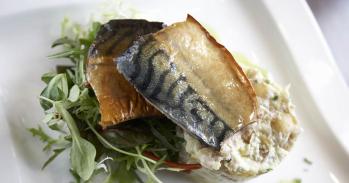
Twelve years after his death, the legacy of distinguished organic chemist Dr Herchel Smith is enabling a new generation of bright young researchers to pursue their scientific ambitions.
Twelve years after his death, the legacy of distinguished organic chemist Dr Herchel Smith is enabling a new generation of bright young researchers to pursue their scientific ambitions.
This legacy continues to make an enormous contribution to our research
Ian Leslie
Anna Guinot Aguado, Maddie Mitchell and Connie Rich are among a unique group of PhD students. Each year Cambridge receives hundreds of applications for a small number of prestigious awards funded by the late Dr Herchel Smith, the scientist behind the development of the oral contraceptive pill. Offered to some of the world’s brightest young life sciences researchers, these studentships honour Smith’s wish to perpetuate academic education in the sciences over the centuries to come.
Spanish-born Anna Guinot Aguado studied in Valencia and Paris before the award of a Herchel Smith PhD studentship enabled her to join Dr Juan-Jose Ventura’s group at the Wellcome Trust/MRC Stem Cell Institute in Cambridge. “Cambridge is one of the best places in Europe for this work and I’m really glad I managed to get in. Competition for funding is extremely fierce and, without the Herchel Smith studentship, I wouldn’t have been able to come here.”
Anna works in a small group studying the behaviour of stem cells in the lungs. “There are many different types of stem cell in the human body and every organ has its own. Their role is to maintain that organ and regenerate it if there’s an injury,” she explained. “We want to understand how stem cells behave in the lungs and why, and what can influence them to be deregulated in the case of disease.”
With implications for a better understanding of lung cancer and potential future treatments, Anna’s cutting-edge research in this relatively new field benefits from a strong network of researchers across Cambridge. “The exciting part for me is that most of our work is in humans, not animal models,” she said. “We receive tumour samples and try to characterise the state of the stem cells in them. We want to understand if stem cells could be at the origin of certain types of lung cancer and, if so, what we could do to somehow stop the progression of disease.”
Maddie Mitchell, also in her third year, said: “the connection with the other Herchel Smith students is really nice – it’s great to be part of a community and share ideas.” Working with Professor Howard Griffiths in the Physiological Ecology Lab in the Department of Plant Sciences, she said, “I’m the only plant scientist student of the current Herchel Smith group – I work on photosynthesis in the single-celled green alga Chlamydomonas reinhardtii. Photosynthesis is a fundamental process – the basis of agriculture and most ecosystems – but it relies on an enzyme that isn’t particularly specific or efficient. There are various mechanisms that have evolved to compensate for that, called carbon-concentrating mechanisms (CCMs), and I’m trying to understand one of these in algae and to look at its molecular regulation.”
With CCMs mediating around 15% of global algal and plant productivity, a better understanding of how they work will underpin future strategies to make photosynthesis more efficient – an important tool in addressing global food and fuel security. “Once we understand the system, we can try and integrate it into higher plants so they have better yields,” explained Maddie, who plans to return to her native Australia after her PhD to put all she has learned in Cambridge to use in research that will benefit agriculture or the environment.
American Connie Rich is a Herchel Smith student in the second year of her PhD. She described her research into the development of olfactory ensheathing cells (OECs): “OECs are a unique type of glial cell that protect and insulate the olfactory nerves, which project from the lining of the nasal cavity into the brain. These are really interesting and are currently being investigated in relation to the repair of spinal cord injuries. Normally when there’s a spinal cord injury, the glial cells block everything off and form a scar to prevent infection. But when you inject OECs, they facilitate regrowth and reconnection of those nerve fibres. So they’re potentially a great repair system, and they have the bonus of being easily accessible in the lining of the nasal cavity.”
“We don’t know why OECs seem to be better at promoting spinal cord repair than glial cells from other nerves, or what makes them different from other glial cells,” she added. Under the supervision of Dr Claire Baker in the Department of Physiology, Development and Neuroscience, Connie is trying to understand how OECs are made and how they function in the embryonic olfactory system, with the long term aim of helping to optimise their isolation for use as a therapy for humans with spinal cord injuries.
Covering all fees and living costs for four years, the Herchel Smith Studentships also provide research, relocation and travel expenses to enable students from around the world to maximise the opportunities that being at Cambridge provides. “I’ve been able to go to at least one international scientific meeting each year, which is very important for networking in my field,” said Anna. “And every two years there’s a meeting with students on the sister programme at Harvard. I went to Harvard last June, where we saw student presentations on the diversity of research going on – it was an amazing experience.” This bi-annual symposium is aimed at fostering the spirit of international exchange and collaboration so valued by Dr Herchel Smith. Alternately hosted by Harvard and Cambridge, it brings together students from Cambridge with those holding Herchel Smith Research Studentships at Harvard University, which has also benefitted from a generous legacy gift.
Following a highly successful career in the pharmaceutical industry, Dr Herchel Smith left substantial legacies to many of the universities and colleges he had been associated with during his lifetime. His bequest of £50 million to the University of Cambridge in 2001 was, at the time, the largest ever individual gift to a British University, and was followed by a further £20,000,000 from the residual estate in 2004. With increasingly limited external funding for PhD students available, philanthropic gifts like this are vital to ensure that fully funded places can be offered to PhD candidates from around the world who demonstrate exceptional academic potential.
The legacy also funds a community of professorships and postdoctoral fellowships in Cambridge. Fund Manager Professor Ian Leslie said, “We have made truly stunning appointments to Herchel Smith Professorships, and the Herchel Smith Postdoctoral programme is providing early career opportunities for very talented researchers. This legacy continues to make an enormous contribution to our research. Our Herchel Smith PhD students are remarkable young men and women, not in only in the research they are doing, but also in their ability to communicate it. The funding is particularly important in providing a link with a sister programme at Harvard, which helps to build networks amongst those with the potential to lead their fields in the future.”
For more information, please contact Jacqueline Garget at the University of Cambridge Office of External Affairs and Communications.
This work is licensed under a Creative Commons Licence. If you use this content on your site please link back to this page.





